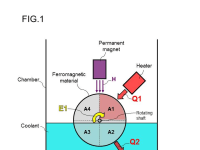The Energy conservation law is dependent on Noether's theorem. According to the Noether's theorem, the symmetry must be established for satisfying the conservation law. In other words, if symmetry breaking occurs, the breaking of the conservation law also occurs. Spontaneous symmetry breaking is occurred at phase transition. Namely, Breaking of the Energy conservation law is occurred at phase transition. Or perhaps, this phenomenon predicts the existence of unknown elementary particles or unknown energies.
As an example of the phase transition, there is a phase transition between a ferromagnetic state and a paramagnetic state in a ferromagnetic material. When thermal energy is input to the ferromagnetic material, the ferromagnetic material is changed to the paramagnetic state at temperature above its Curie temperature. When such hot ferromagnetic material releases the thermal energy to an outside, the ferromagnetic material is changed to the ferromagnetic state at temperature below its Curie temperature.
A Thermo-magnetic engine shown in Figure 1 comprises a circular shaped ferromagnetic material, a heater, a permanent magnet, a coolant and a chamber. Figure 3 shows input and output energies related to the ferromagnetic material.
The magnet applies a magnetic field H to Portions A1 and A4 of the ferromagnetic material. The heater supplies a thermal energy Q1 to the Portion A1 of the ferromagnetic material, so the Portion A1 is changed to the paramagnetic state.
An attracting force between the ferromagnetic Portion A4 and the magnet is greater than an attracting force between the paramagnetic Portion A1 and the magnet. Then, the ferromagnetic material rotates clockwise and a rotational energy E1 is generated. As shown in Figure 2, the hot Portion A1 moves to a bottom area and releases a thermal energy Q2 to the coolant. The Portion A1 is changed to the ferromagnetic state again. Subsequently, the heater supplies the thermal energy Q1 to the Portion A4 of the ferromagnetic material, so the Portion A4 is changed to the paramagnetic state. In this way, the ferromagnetic material continues to rotate.
By a magnetocaloric effect, the temperature of the ferromagnetic material decreases with increasing distance from the magnet. Also, the temperature of the ferromagnetic material increases with decreasing distance from the magnet. These temperature changes are canceled each other. An eddy current is output as a part of thermal energy Q2. A thermal expansion of the ferromagnetic material contributes to clockwise rotation.
An input energy input to the ferromagnetic material is the thermal energy Q1. Output energies outputted from the ferromagnetic material is the thermal energy Q2 and the rotational energy E1. A sum of the output energies Q2 and E1 is greater than the input energy Q1.
Of course the rotational energy E1 is smaller than the thermal energy Q1. However, the total output energy including exhaust heat is greater than the input energy Q1. This energy relationship indicates the Breaking of the Energy conservation law. This is an innovation of Physics.
Like this entry?
-
About the Entrant
- Name:Tomooki Seki
- Type of entry:individual
- Software used for this entry:PowerPoint
- Patent status:pending








